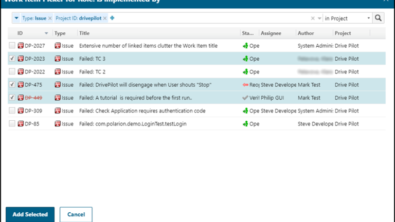Products
Morris Medical Monthly: RiskPack Basics (Part 2 of 2)
Welcome back to Morris Medical Monthly: a monthly series for medical device development companies (and companies who are related to such companies), providing some useful information about Polar...
Welcome back to Morris Medical Monthly: a monthly series for medical device development companies (and companies who are related to such companies), providing some useful information about Polarion solutions and Polarion extensions.
Today we will start on the subject of Polarion’s RiskPack extension, and have a look into RiskPack’s Basics.
How information is prepared for visualisation
Because storing data can be very flexible done (see last section), so must be data visualisation. RiskPack uses a
socalled Risk Table and a Sequences Of Events Table for this. The Sequences Of Events Table shows every
sequence of events entry in a separate row. Which columns are shows can be freely configured depending on the
information that is linked to to sequence of events. In the example above, the table would have a separate column
containing the system cmponent(s), hazard(s), hazardous situation(s) and harm(s). If other types of information is
stored, they can be additionally are alternatively be visualized.
The same applies to the Risk Table. The Risk Table shows a separate row for each risk and displays the sequence
of events that is considered by the risk as well as any risk control measures and risks estimations other those
measures have been applied.
How risk control is done
The former sections explained how risk analysis is done, i.e. how a sequence of events that leads to a harm can be
documented and estimated for its probability of occurence. With this information, a two-dimensional matrix with a
severity and a probability axis that summarizes the number of risks in each category can automatically be drawn.
RiskPack calls this Risk Control Matrix. Some severity/probability combinations will be accepted, some won’t. So
there might be the need for risk mitigation. RiskPack uses a data type “risk control measure” for this. A “risk control
measure” describes the measure needed to mitigate a risk. Which risk is mitigated is identified by linking the
measure to the risk the measure it is mitigating. After mitigation, the initial risk is reevaluated. RiskPack uses a new
risk entry for this, which is linked to the initial risk but is a separate information stored in an additional work item.
How this is practically done is explained in more detail in the Getting Started section.
How the current status of the documentation can be controlled
As explained above, every sequence of events and every risk control measure (as well as anything else) is stored as
a single piece of information. If that is done, it is important to know the status of the information. For example, is the
documentation of the sequence of events still in a draft status or has it been reviewed? Has the risk control measure
already been implemented and tested? To keep track of the status, the standard Polarion status and workflow
functionality is used. The status model depends on the template you are using, but you are also free to change it to
your needs.
How the risk management file is created
The RiskPack uses Polarion wiki pages for documentation. So the final risk management file is a collection of
Polarion wiki pages. For offline use, Polarion’s export capabilities can be used to created PDF documents. RiskPack
also works with Polarion’s Time Machine mode, so it is possible to (re)create historical documentation as well.
For more information about Polarion’s RiskPack visit our Extension Portal using following link:
http://extensions.polarion.com/extensions/184-polarion-alm-riskpack-iso-14971. I hope you liked this article and you will visit our Blog again when there is another Morris Medical Monthly article.


